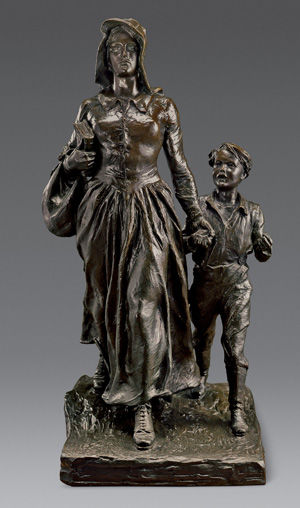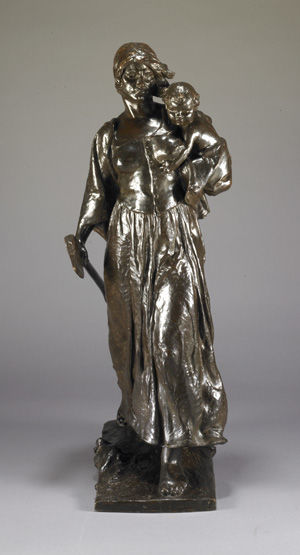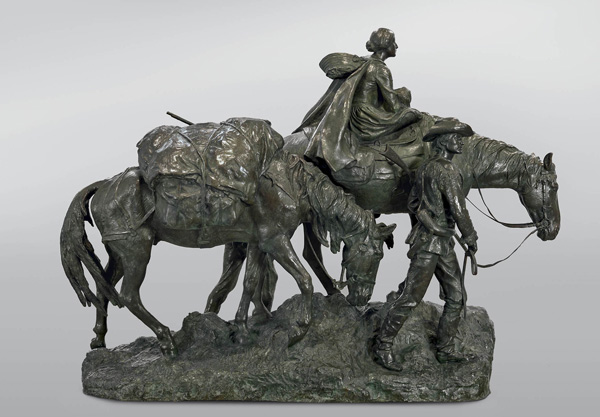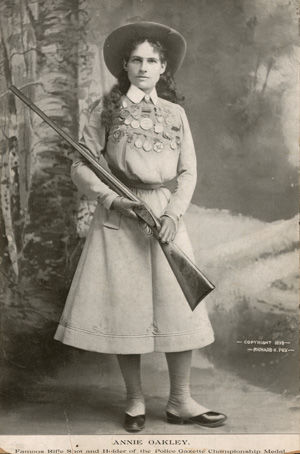
Bryant Baker (American, born England, 1881–1970). Pioneer Woman, 1927–30 (dedicated 1930). Ponca City, Oklahoma. Photograph © Larry Ulrich
On April 22, 1930, Bryant Baker's seventeen-foot bronze statue Pioneer Woman was unveiled in Ponca City, Oklahoma, before a crowd of forty thousand spectators. At the dedication ceremony, patron Ernest W. Marland—oil man, philanthropist, and the tenth governor of Oklahoma—described the commission: "We have erected monuments to our war heroes, to the hearty pioneers who wrested from the wilderness, from the plains and from the desert this nation of ours, but have we preserved the memory of the women…who married their men and set out with them on their conquest of the west, faced with them the months of arduous toil and terrible dangers?…With this monument I hope to preserve for the children of our children the story of our mothers' fight and toil and courage."
Four years prior, Marland invited twelve American sculptors—including Bryant Baker, A. Sterling Calder, Jo Davidson, James Earle Fraser, and Hermon Atkins MacNeil—to compete for the commission. Each artist submitted a two-foot bronze model for the monument, which was to express, in Marland's words, "the spirit of the pioneer woman—a tribute to all women of the sunbonnet everywhere." The winner would be determined by a popular vote and the models were sent on a six-month tour of several U.S. cities, from New York and Boston to Minneapolis and Fort Worth. Tens of thousands of ballots were cast, and Baker's model won by a margin of nearly two to one.


Above top: Bryant Baker (American, born England, 1881–1970). Pioneer Woman, 1927. Bronze, 32 x 15 x 16 1/4 in. (81.3 x 38.1 x 41.3 cm). Woolaroc Museum, Bartlesville, Oklahoma. Right: Hermon Atkins MacNeil (American, 1866–1947). Above bottom: Pioneer Woman, 1926. Bronze, 35 x 12 x 15 in. (88.9 x 30.5 x 38.1 cm). Saint Louis Art Museum, Gift of Furniture Brands (78:2007)
Striding confidently forward, Baker's Pioneer Woman depicts a mother leading her young son by the hand. She also carries a Bible and a sack, symbols of her faith, morality, and status as provider. Although sculptural depictions of frontier women are far less common in western art than cowboys or American Indians are, when women are portrayed they are typically presented as emblems of ideal motherhood. In fact, Jo Davidson was the only artist to submit a model in which a pioneer woman is represented without a child. Far more popular was the stereotypical image of the frontier Madonna, as seen in Hermon Atkins MacNeil's submission to the competition.
Sculptor Alexander Phimister Proctor also memorialized the maternal role of pioneer women in his monumental bronze Pioneer Mother. Dedicated in Kansas City, Missouri, in December 1927, the work was commissioned by businessman Howard Vanderslice. In his autobiography, posthumously published in 1971, Proctor described his vision of the sculpture: "…the statue was a group of weary pioneers traveling westward over the prairie. The young mother, the principal figure, rode horseback, carrying a baby in her arms—the hope for the future of the West." While conventional depictions of the pioneer celebrate masculine heroism, Proctor's sculpture acknowledges the important role of women in western expansion; as the artist explained, "I considered the heroism of the women equal to, and perhaps greater than, the men's."

Alexander Phimister Proctor (American, born Canada, 1860–1950). Pioneer Mother, 1925 (cast 1927). Bronze, 56 x 28 1/2 x 82 in. (142.2 x 72.4 x 208.3 cm). Santa Barbara Museum of Art, Gift of the A.E. Clegg Family (1991.89.II)
Public monuments dedicated to the pioneer woman were erected in several western cities, notably after the ratification of the Nineteenth Amendment in 1920, when women's right to vote was federally recognized. However, these tributes focused overwhelmingly on the western woman as ideal mother, failing to recognize the diverse experiences, roles, and responsibilities of women on the frontier. Apart from childrearing and housekeeping—traditional "women's work"—many pioneer women toiled outside the home, plowing fields, digging wells, building fences, slaughtering chickens, and milking cows. Some found employment as domestic servants, shopkeepers, teachers, and boarding house proprietors, while others entered into the male-dominated fields of law, medicine, science, art, and journalism. There were successful female prospectors who owned mining companies, and women who earned national reputations for their skills as sharpshooters, such as Annie Oakley, and hell-raisers, such as Calamity Jane (Martha Jane Canary).

Annie Oakley [Famous Rifle Shot and Holder of the Police Gazette Championship Medal], 1899. Halftone print, 13 7/8 x 9 1/8 in. (35.3 x 23.1 cm). Prints and Photographs Division, Library of Congress, Washington, D.C.
Many pioneer women were also active in the social movements of the era, from labor rights and temperance to the right to vote. In fact, the first four states to adopt women's suffrage were in the West: Wyoming (1890), Colorado (1893), Utah (1896), and Idaho (1896). Interestingly, by 1890, a greater percentage of women were professionally employed in the West than in the East. To quote historians Linda Peavy and Ursula Smith, these women were the "molders and shapers of western society," making noteworthy contributions to the cities, towns, and communities in which they lived.
Although few artists approached the subject of the pioneer woman, sculptural representations of this heroine play an important role in memorializing the achievements of western women in the public's consciousness.
Additional Reading
Broder, Patricia Janis. "The Pioneer Woman, Image in Bronze." American Art Review 2, no. 5 (September–October 1975): 127–134.
Peavy, Linda, and Ursula Smith. Pioneer Women: The Lives of Women on the Frontier. Norman: University of Oklahoma Press, 1998.
Tolles, Thayer, Thomas Brent Smith, et al. The American West in Bronze, 1850–1925. New York: The Metropolitan Museum of Art; New Haven: Yale University Press, 2013.